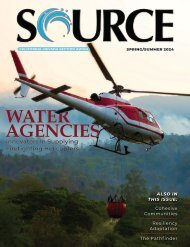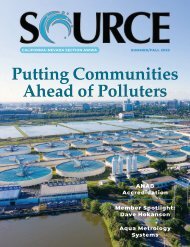SOURCE - Spring 2025
For more information on upcoming webinars, certification updates, and compliance guidance, please visit the CA-NV AWWA website at ca-nv-awwa.org. Contact Steven Garner at sgarner@ca-nv-awwa.org to be added to the community forum.
For more information on upcoming webinars, certification updates, and compliance guidance, please visit the CA-NV AWWA website at ca-nv-awwa.org. Contact Steven Garner at sgarner@ca-nv-awwa.org to be added to the community forum.
Transform your PDFs into Flipbooks and boost your revenue!
Leverage SEO-optimized Flipbooks, powerful backlinks, and multimedia content to professionally showcase your products and significantly increase your reach.
Phibro-tech photo courtesy of Phibro-Teck. Tank p hoto courtesy of Phil Chandler.
with the water system’s treatment
operators to oversee the
regeneration process.
The Path Ahead
Although Phibro-Tech set out
to simply provide the Roll-Up
Regeneration component, the
company has teamed up with
other companies that together can
offer a complete Cr6 solution. In
addition to Datumpin, the group
includes the global equipment
manufacturer Chart Water, and
Ecolab providing Purolite Resins.
Several drinking water providers
are conducting pilot studies to
optimize their SBA treatment using
Roll-Up Regeneration. Phibro-
Tech’s Regional Sales Manager
Jeremy Rosenfeld states that
several other water systems are
learning more about the benefits
of their innovation on this proven
treatment approach.
“The things they like best are how
easy it is for the operators, the
efficient regeneration process,
and not needing to use dangerous
chemicals in the treatment process
or store a hazardous substance onsite,”
said Jeremy.
Jeremy noted the capital
cost is lower than most other
treatment solutions, and by
optimizing Roll-Up Regeneration
the operating cost is also very
competitive.
About the author:
Phil Chandler is
an environmental
Systems Engineer
with 30 years of
experience in
water, gas and oil
applications. Phil
has led complex environmental
research and equipment
engineering programs in the
UK, USA, Europe and Japan. Phil
currently serves as President of
datumpin inc which provides asset
health data services for a range of
equipment applications.
With 8-foot ion exchange vessels behind it, a Phibro-Tech
tanker prepares to offload brine in Rosemead, CA.
Ion Exchange 101
Ion exchange (IX) resin treatment is a “best available technology”
(BAT) for hexavalent chromium. The choices include “strong
base” or “weak base” anion exchange resin, abbreviated as SBA
or WBA. The resin choice is driven by water chemistry.
Weak Base (WBA): Operations with high total dissolved solids
(TDS) may want to consider WBA.
With WBA IX treatment, the influent water pH must first be
lowered by adding acid or CO2 so that the resin is in the right
form for chromate uptake. Subsequently, the pH must be
readjusted after the IX treatment to the same level as the influent
to prevent corrosion potential before going to distribution. WBA
IX treatment has been operational at a Superfund site in Glendale,
California following a landmark research project that ran from
2001-2015. WBA IX beds can treat for years before a change out is
required. A drawback for WBA is that the resin also attracts and
builds up uranium over time which can trigger special disposal
requirements for radioactive waste.
Strong Base (SBA): the advantage is it operates at neutral pH
and can be regenerated with a low-cost salt brine. The length of
the service cycle is dictated by the other TDS in the water. When
the IX hits a predetermined Cr6 effluent level, a regen is initiated
where the chlorides in the regenerant replace the Cr6 on the
resin bead.
First-generation SBA chromium (VI) treatment vessels and a brine tank were all
housed in containers, with elaborate controls and a separate waste brine tank.
Spent brine is captured and hauled away for further processing.
Because the frequency of regeneration, generally, relatively low
levels of other anions, including uranium, do not require special
handling. Any brine stored on-site after regeneration is classified
as hazardous waste due to the Cr6levels.
‒ By Cathy Swanson, Director of Business Development for
Emerging Markets for EcoLab Purolite Resins
www.ca-nv-awwa.org | SPRING 2025 17






